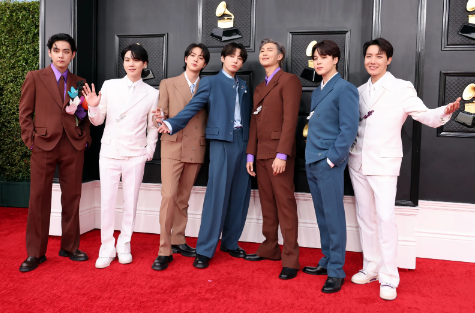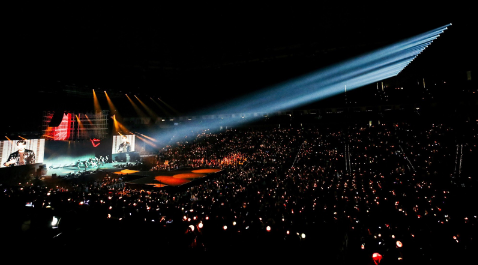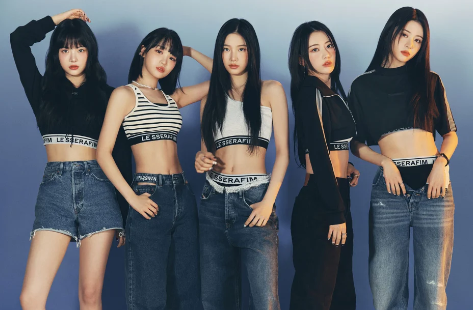Hae-jeen Ryou
Generation Three
With a sturdy foundation of choreography, vocals, and merchandise from the previous generations, the years 2012-2018/2019 represent the third generation of K-pop. During this generation, the Hallyu Wave starts to expand to the Western Hemisphere. While Western media infiltrated Korean media for decades before this time, Korean media finally reached the West and is still expanding its global audience. Some would argue that Psy’s “Gangnam Style” in 2012 was the start of Generation Three, others believe that groups such as EXO, BTS, Seventeen, TWICE, and Blackpink paved the way. When Psy’s viral music video became a huge sensation, K-pop was introduced to many who did not know this genre of music existed. Soon, fans became curious about K-pop, allowing people to find other third generation groups.

Figure 1. BTS at the 2022 Grammy Awards
With this influx of attention, Generation Three started debuting a string of members called the “global line”. These members are artists that are not from Korea but went through similar training periods to debut. Trainees spend months to years practicing dancing, singing, rapping, acting, and more while going to school. These students spend hours a day in a practice room honing their skills to hopefully debut and transition into “idol” status. International trainees would take additional classes to learn Korean and experience Korean culture. These members are a crucial part of each team in performances, but also when communicating with fans from different countries. As K-pop continues to expand, groups want to ensure they can communicate with fans around the world. Idols can audition from practically anywhere, including the United States, Canada, Australia, Britain, Indonesia, Thailand, Japan, China, Mongolia, and more.
This extended communication is especially helpful when groups started Asia and World Tours. As Korean media became popular, entertainment companies fulfilled international fans’ wishes to see their favorite artists in person. These tours could last for months, or even a year, and allowed artists to meet their fans. Many groups have a translator at venues to be able to communicate more easily. Members who can speak the fan’s language fluently communicate without delay, creating an exciting concert experience for both fans and artists.

Figure 2. Seventeen’s “Be the Sun” World Tour in Ft. Worth, Texas
Much of Generation Three’s merchandise was similar to Generation Two, but photocards and light sticks became a staple in the K-pop industry. More advancements in advertisement and merchandise were made in Generation Four.
Generation Four
The fourth generation of K-pop groups starts around 2018/2019, bringing a new era of sound and sampling. Groups and producers experiment with different genres and instrumentation that are not traditional in K-pop. In the early stage of Generation Four, many groups sampled tracks from classical music, such as J.S Bach’s “Air on the G String” in Red Velvet’s “Feel My Rhythm,” or Beethoven’s “Symphony No. 9” in Ateez’s “Wonderland.” Additionally, some groups started sampling tracks from other music, such as Frere Jacques’ “Traditional Folk” in NMIXX’s “Young, Dumb, Stupid,” and “I Will Survive” by Gloria Gaynor in IVE’s “After Like.” Along with samples in songs, Generation Four starts expanding into different genres of music. Groups and solo artists are expanding into genres like reggaetón, such as LE SSERAFIM’s “Fire in the Belly” and Kai’s “Rover,” or rock and hip-hop in Stray Kids’ “Time Out” and “District 9”.

Figure 3. LE SSERAFIM, Generation Four Artist
This is also the generation of COVID-19. Covid greatly affected the K-pop industry. Due to social distancing requirements, idols were not able to meet fans in person or go on tours. This resulted in many events moving to a virtual platform and forced companies and fans to find creative ways to support each other during these rough times. In-person fan-sign events and concerts were moved online and even merch became available virtually.
Fans all over the world would use social media like X (formerly Twitter) to publish forums and post compilation videos of themselves singing the artists’ songs. Official fan accounts would team up with the artists’ management company and send these videos to show at concerts as a surprise event/gift for the artist. Fans also showed support by ordering café or food trucks and sending them to the artists’ filming sites so the artists and staff could eat while working.
Although the pandemic was a hard and bleak time, it created new methods of entertainment. Even now as the pandemic has relaxed, many artists continue to have online and in-person concert tickets for both Korean fans and international fans. They also have online opportunities such as birthday and anniversary events and web magazines.
As K-pop and the Hallyu Wave continue to grow, more generations of K-pop will emerge and bring new music and entertainment to a vast worldwide audience. Some say Generation Five is already here, with new groups such as NewJeans, ZEROBASEONE, and BoyNextDoor bringing a happier and more nostalgic sound. Others say K-pop is in a transition phase, but fans can only wait with hope to see what Generation Five and beyond can bring to this genre of music.
Check out our playlist featuring music from the groups mentioned in this blog!



Juliana Vasconcelos
I love the article! Just a note: I believe Red Velvet is gen-3, since they debuted in 2014 :)
Thanks for the amazing work! I’m doing my final project for Uni this year and it’s about Hallyu and consumer behavior! So I would love to connect with some people who talk about the Korean Wave! If you’re interested in discussing the topic and participating of my research, please e-mail me, it’s going to be a pleasure!